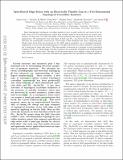| dc.contributor.author | Liu, Junwei | |
| dc.contributor.author | Hsieh, Timothy Hwa-wei | |
| dc.contributor.author | Wei, Peng | |
| dc.contributor.author | Duan, Wenhui | |
| dc.contributor.author | Moodera, Jagadeesh | |
| dc.contributor.author | Fu, Liang | |
| dc.date.accessioned | 2014-07-24T19:55:31Z | |
| dc.date.available | 2014-07-24T19:55:31Z | |
| dc.date.issued | 2013-12 | |
| dc.date.submitted | 2013-09 | |
| dc.identifier.issn | 1476-1122 | |
| dc.identifier.issn | 1476-4660 | |
| dc.identifier.uri | http://hdl.handle.net/1721.1/88495 | |
| dc.description.abstract | Three-dimensional topological crystalline insulators were recently predicted and observed in the SnTe class of IV–VI semiconductors, which host metallic surface states protected by crystal symmetries. In this work, we study thin films of these materials and expose their potential for device applications. We demonstrate that thin films of SnTe and Pb1−xSnxSe(Te) grown along the (001) direction are topologically non-trivial in a wide range of film thickness and carry conducting spin-filtered edge states that are protected by the (001) mirror symmetry through a topological invariant. Application of an electric field perpendicular to the film will break the mirror symmetry and generate a bandgap in these edge states. This functionality motivates us to propose a topological transistor device in which charge and spin transport are maximally entangled and simultaneously controlled by an electric field. The high on/off operation speed and coupling of spin and charge in such a device may lead to electronic and spintronic applications for topological crystalline insulators. | en_US |
| dc.description.sponsorship | United States. Dept. of Energy (Office of Basic Energy Sciences, Division of Materials Sciences and Engineering, Award DE-SC0010526)0006423) | en_US |
| dc.description.sponsorship | National Science Foundation (U.S.) (Graduate research fellowship No. 0645960) | en_US |
| dc.description.sponsorship | China. Ministry of Science and Technology (Grant No. 2011CB921901) | en_US |
| dc.description.sponsorship | China. Ministry of Science and Technology (Grant No. 2011CB606405) | en_US |
| dc.description.sponsorship | National Natural Science Foundation (China) (Grant No. 11074139) | en_US |
| dc.description.sponsorship | National Science Foundation (U.S.) (MIT MRSEC Program Award No. DMR-0819762) | en_US |
| dc.description.sponsorship | National Science Foundation (U.S.) (NSF DMR grant 1207469) | en_US |
| dc.description.sponsorship | United States. Office of Naval Research (ONR grant N00014-13-1-0301) | en_US |
| dc.language.iso | en_US | |
| dc.publisher | Nature Publishing Group | en_US |
| dc.relation.isversionof | http://dx.doi.org/10.1038/nmat3828 | en_US |
| dc.rights | Article is made available in accordance with the publisher's policy and may be subject to US copyright law. Please refer to the publisher's site for terms of use. | en_US |
| dc.source | arXiv | en_US |
| dc.title | Spin-filtered edge states with an electrically tunable gap in a two-dimensional topological crystalline insulator | en_US |
| dc.type | Article | en_US |
| dc.identifier.citation | Liu, Junwei, Timothy H. Hsieh, Peng Wei, Wenhui Duan, Jagadeesh Moodera, and Liang Fu. “Spin-Filtered Edge States with an Electrically Tunable Gap in a Two-Dimensional Topological Crystalline Insulator.” Nature Materials 13, no. 2 (December 22, 2013): 178–183. | en_US |
| dc.contributor.department | Massachusetts Institute of Technology. Department of Physics | en_US |
| dc.contributor.mitauthor | Liu, Junwei | en_US |
| dc.contributor.mitauthor | Hsieh, Timothy Hwa-wei | en_US |
| dc.contributor.mitauthor | Wei, Peng | en_US |
| dc.contributor.mitauthor | Moodera, Jagadeesh | en_US |
| dc.contributor.mitauthor | Fu, Liang | en_US |
| dc.relation.journal | Nature Materials | en_US |
| dc.eprint.version | Author's final manuscript | en_US |
| dc.type.uri | http://purl.org/eprint/type/JournalArticle | en_US |
| eprint.status | http://purl.org/eprint/status/PeerReviewed | en_US |
| dspace.orderedauthors | Liu, Junwei; Hsieh, Timothy H.; Wei, Peng; Duan, Wenhui; Moodera, Jagadeesh; Fu, Liang | en_US |
| dc.identifier.orcid | https://orcid.org/0000-0002-8803-1017 | |
| dc.identifier.orcid | https://orcid.org/0000-0001-8051-7349 | |
| dc.identifier.orcid | https://orcid.org/0000-0002-2480-1211 | |
| dc.identifier.orcid | https://orcid.org/0000-0001-8187-7266 | |
| dc.identifier.orcid | https://orcid.org/0000-0003-2289-6007 | |
| mit.license | PUBLISHER_POLICY | en_US |
| mit.metadata.status | Complete | |
